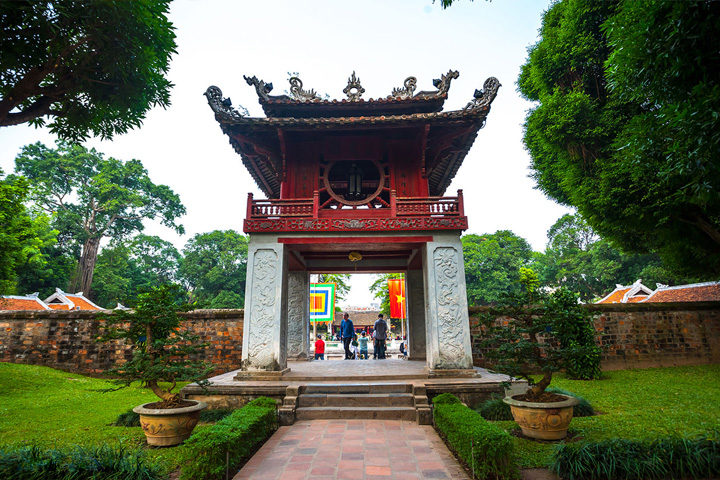Listed by the Vietnamese government as one of the most important historical relics all over the country, Van Mieu – Quoc Tu Giam or The Temple of Literature in Hanoi is a must-visit site for tourists when they first come to the thousand-year-old city of Hanoi. In the past, the temple educated thousands of talented scholars serving different dynasties. Nowadays, though not serving as country’s best university, the Temple of Literature is a place to honor students with excellent achievements.

Overview of temple of literature
The history of Temple of Literature
The Temple of Literature was constructed in 1070 under the reign of Emperor Ly Thanh Tong to dedicate to Confucius, sages, and scholars. The temple operated as a royal university educated its first student who was the crown prince Ly Can Duc – son of the queen Y Lan and the Emperor Ly Thanh Tong. In 1076, the emperor established Quoc Tu Giam next to the temple, aiming to open a school for royal members and officials’ families.

inside the temple of literature
In 1253, Tran dynasty, the emperor Tran Thai Tong officially opened the school to the public, ordinary people were allowed to apply but only the excellent would be accepted. Under the reign of Hau Le dynasty, Confucianism blossomed, the emperor Le Thanh Tong erected steles of carved blue stone turtles to honor talent and encourage study.
The architecture
Since 1070, the Temple of Literature has undergone much maintenance under different reigns. However, the entire layout was constructed under Nguyen dynasty, consists of Van lake, Giam park and the interior courtyards which are surrounded by a brick wall.

The Van lake – temple of literature
The Van lake or commonly known as Giam lake is right in front of the entrance to the temple. An interior courtyard is a sacred place isolated by the Giam park and the wall, separated into five different areas to honor historical figures.

Entrance gate of the temple of literature
Van Mieu entrance is the first entrance leading to the interior courtyards. It has three gates: one main gate and the other two sub-gates. The entrance was designed in accordance with feudal architecture.
Dai Trung entrance: from the Van Mien entrance, passing another entrance tourist should find themselves at Dai Trung entrance. Along the way, beautiful and well-cared gardens would present a fine place for any shoots.

Khue Van pavilion – the temple of literature
Khue Van pavilion: straight from Dai Trung entrance, Khue Van pavilion was built in 1805 on four white-washed stone stilts and nowadays, stands as a symbol of the thousand-year-old capital city of Hanoi. In the past, Khue Van serves as a meeting place for contestants competing to be the emperor’s officials.
Thien Quang well: the name “Thien Quang” meaning the well light up the sky implies that this is the place where universe’s quintessence gathers and where humans could attain wisdom, be enlightened. Surrounding the well is the Stelae of Doctors depicting the names of 1307 graduates of 82 triennial royal exams mostly held by the Le dynasty. That Stela is a valuable source to study Vietnamese culture.
Dai Thanh entrance: this is the most sacred place dedicating to honor people with great influence and contributions to Vietnamese culture.


